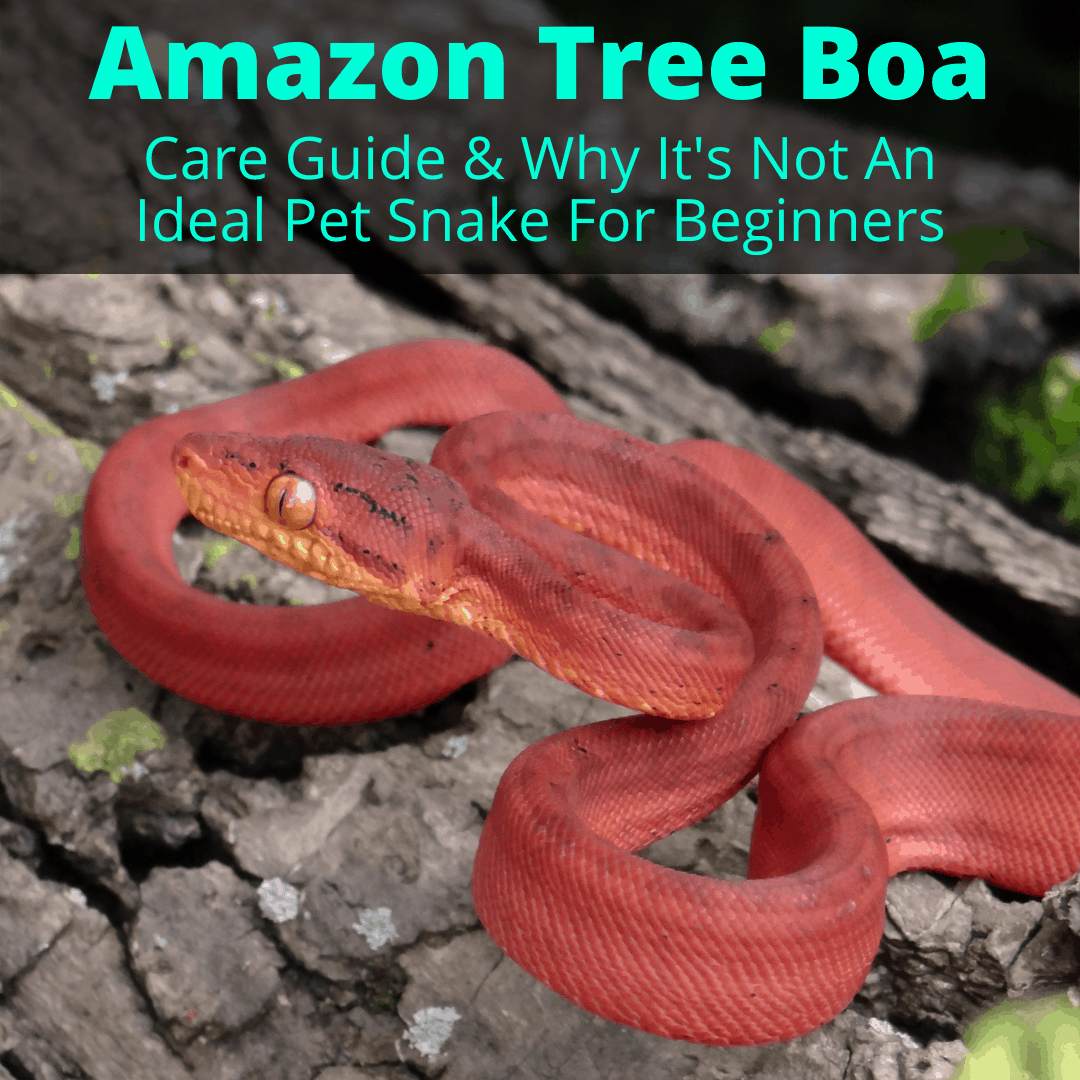
It is a stunning snake.
But it does not make a good pet for everyone.
This snake is aggressive and has some pretty strict requirements.
It can be a beautiful pet for an experienced snake owner, but not for a beginner.
Despite that, we know many beginners will want to get one anyway. Before you do, please read our Amazon Tree Boa care guide below.
We’ll cover everything you need to know to care for this snake and we’ll give you a lot of important facts as well. In fact, let’s begin with some quick facts, before diving into the care guidelines.
Table of Contents
Amazon Tree Boa: Quick Facts
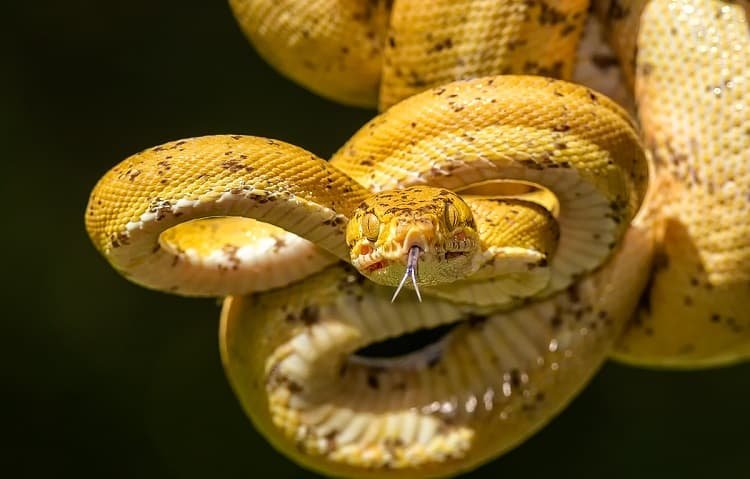
If you don’t know much about the Amazon Tree Boa, here’s a crash course.
- These snakes are found in Costa Rica, and the Amazon rainforest in Ecuador, Bolivia, Guyana, Peru, southern Venezuela, Brazil, and southern Colombia.
- Amazon tree boas are solitary snakes that like to spend most of their time in trees.
- They’re active during the night as well as the day.
- They have long teeth that result in painful bites.
- As a defensive mechanism, they release a musk (bad-smelling liquid) when threatened.
- Amazon Tree Boas are carnivores and like to eat bats, frogs, birds, lizards, and rodents.
- Despite being a type of boa constrictor, these snakes don’t become too large. They can reach between 5 and 6.5 feet in length, with females being a bit larger than the males.
- Despite their length, these snakes are thin. You’ll find that the widest parts of their bodies are only one or two inches in diameter.
- The Amazon Tree Boa flaunts a variety of patterns and colors that you don’t see on many snakes. You can find them with gray, brown, yellow, red, or orange on their bodies. Many of them have bands, speckles, or chevron shapes, but you can also find Amazon Tree Boas that have no patterns at all.
- When hunting at night, the Amazon Tree Boa uses its pit sensors to sense the heat of their prey. When hunting during the day, they use their good eyesight.
- These snakes are non-venomous but kill their prey by striking at them quickly and using their needle-like teeth to bite. They also constrict their prey.
- With the right care, these snakes can live for up to 20 years in captivity. It’s unknown how long they can survive in the wild.
- In the wild, the type of environment that these boas prefer varies quite a bit. You can find them in arboreal areas that have high levels of humidity, and an example of this environment is the Amazon rainforest. However, Amazon Tree Boas can also be found in drier regions like savannas. They are usually found in trees, between one and two meters above the ground. However, they are sometimes active on the ground as well.
Amazon Tree Boa Care
Caring for an Amazon Tree Boa is not as easy as some other snakes. They need a fairly specific environment and they are very aggressive.
We would not recommend this snake for a beginner (try any of these boa breeds instead), but it can make a good pet for a more experienced snake owner. Let’s dive right in and see what it takes to care for this snake, starting with the enclosure.
Enclosure
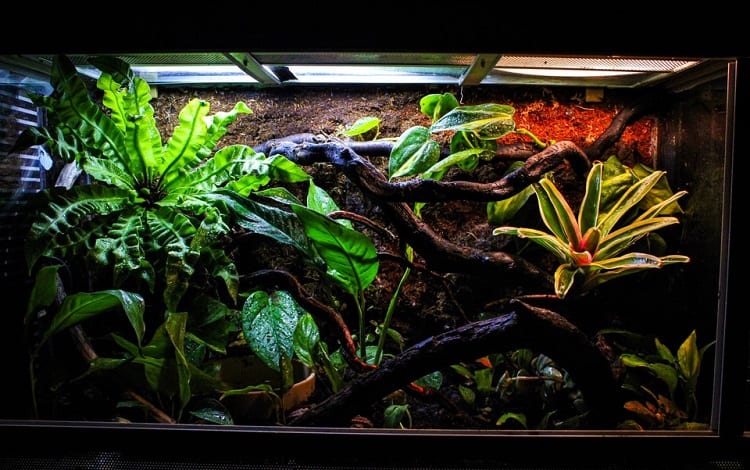
The Amazon Tree Boa needs a fairly large terrarium and a temperate, but humid environment.
Enclosure Size
The ideal enclosure for this species has a length that’s at least 80 percent of the snake’s body length. Bear in mind that these snakes can grow up to five feet or longer!
You also want to make sure that the height of the enclosure is a minimum of half the snake’s length. Don’t be afraid to give them more height than that, because they will love to climb.
Environment
The Amazon Tree Boa likes a temperate environment, with both cooler and hotter areas in its enclosure. The cool part of the cage should be between 70° and 75° Fahrenheit, while the warmer basking area needs to be around 85°.
These snakes don’t need UV lighting in their enclosures. A regular incandescent reptile bulb or infrared heat bulb is a good way to give your reptile what it needs, and when placed above the cage this actually stimulates the snake to climb.
Naturally, this means providing your pet with plenty of climbing opportunities. Give it vines and branches, so that it can feel right at home. More on this below.
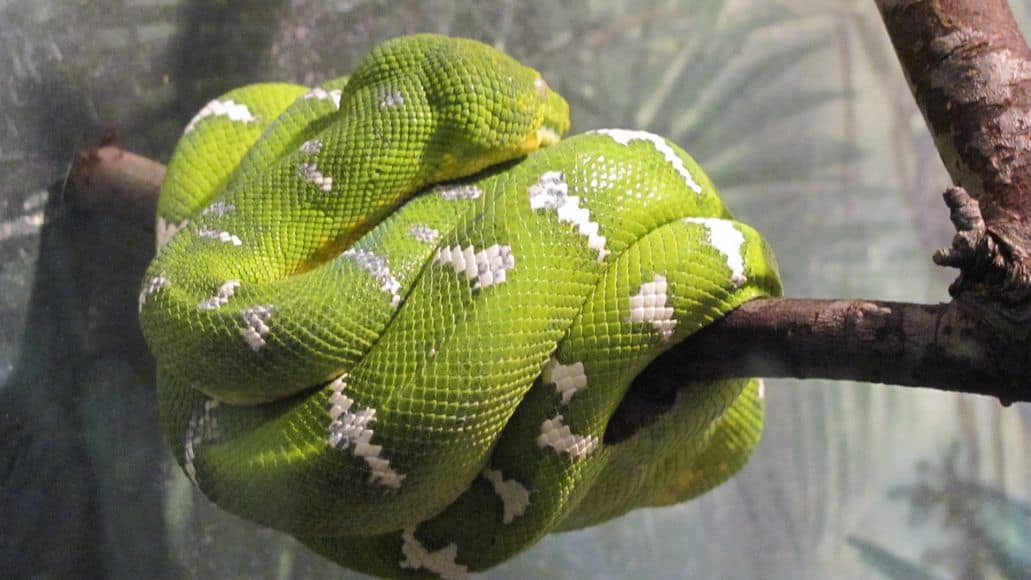
Make sure that your boa always has a bowl of fresh water available. They use this for soaking as well as hydration.
You should also mist your boa at least once a day to help it get the amount of humidity it needs. What’s the ideal humidity for an Amazon Tree Boa?
These snakes require a lot of humidity. It should be between 60 to 80 percent. If you live in a dry climate, you might want to consider a humidifier for your snake, so that you don’t have to keep manually misting it. A fogging machine works well, too.
Substrate
Once you’ve settled on the best enclosure for your Amazon Tree Boa, make sure you lay down the correct bedding/substrate for your snake.
It should absorb moisture. Coco husk is ideal. The substrate should always be a little bit moist, like their natural environment, so you’ll also want to mist it regularly.
Location
The enclosure should not be in a high-traffic area of the home. They can strike out often, whenever they sense any movement. You don’t want your boa to continuously strike its head against the glass of its tank. It could end up injuring itself.
Food And Water
The Amazon Tree Boa can eat pre-killed or live rodents. If you’re going to be giving your snake frozen-thawed prey, it might have to eat a few live rodents before it gets used to the pre-killed variety.
Avoid the temptation to feed multiple prey items during one feeding as this can be harmful to your boa. In fact, this is one of the most common causes of death in captive boas.
This snake will eat as much as you give it – it’s quite an opportunistic eater! You want to give your snake enough food that it satisfies its hunger, without overfeeding it. You don’t want a fat snake.
A good way to ensure you don’t overfeed is to check that your snake can still be active after eating. Remember, this snakes evolved to be slim so that it can move freely in tree branches.
Feed baby Amazon Tree Boas every seven to 10 days and adults every 10 to 14 days.
Amazon Tree Boas can dehydrate quickly so you need to ensure they always have clean fresh water in their bowls. The bowls should also be large enough to allow the boas to soak. These snakes love the water.
Handling
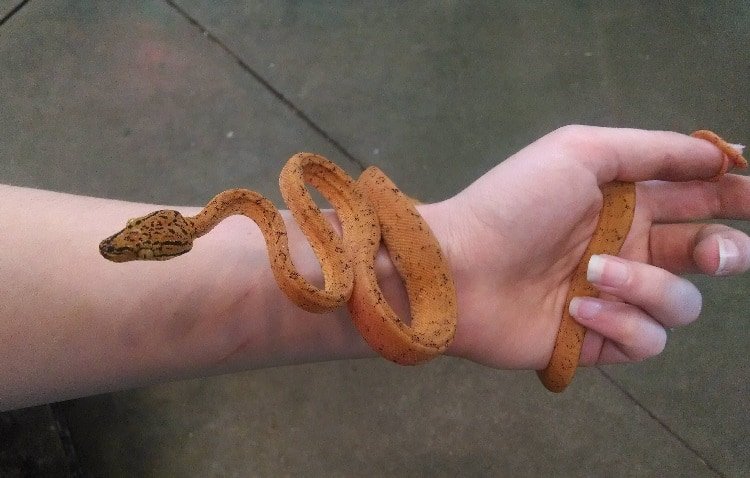
Don’t handle the snake unless it’s necessary. The Amazon Tree Boa doesn’t like being touched or handled, and could bite in self-defense.
Although it is not venomous, any snake bite can be painful and one from an Amazon Tree Boa could even draw blood!
A successful method of transferring your snake from one enclosure to another, which you’ll have to do when you deep-clean your boa’s cage, is to use a snake hook that’s long enough so that the snake won’t be able to strike out at you. Never get too close to the snake, especially with your face or head.
Health
These snakes are prone to certain health issues, like parasites. This is as a result of being wild-caught. If you suspect that your Amazon Tree Boa has a parasite, it’s essential to take it to an exotic pet vet who can treat it with prescription medication.
Another common condition that affects Amazon Tree Boas is mites. These can make your snake very uncomfortable.
Health conditions in your snake are usually a result of poor husbandry, so make sure you follow the correct hygiene tips. For example, spot-clean your snake’s enclosure on a daily basis and give it a deep clean every few weeks.
Climbing Branches
The Amazon Tree Boa loves to climb, so you want to provide it plenty of opportunities to do so in its cage. All branches should be at least as wide as the snake’s diameter, so that it can sit on it comfortably.
This snake also likes v-shaped branches. Put some branches at slight angles so that they it climb from one to the other.
If you’re using real branches in your boa’s enclosure, make sure to steer clear of cedar and pine branches. These are hazardous to the snake because they release aromatic oils that irritate their respiratory tracts.
A good alternative is cork board. A nice bonus is that it is resistant to mold. That comes in handy considering the high humidity this species likes in its enclosure.
Breeding
I have some good news. Breeding Amazon Tree Boas is an easy process.
They breed during the colder winter months, though the temperature only drops by about 9° Fahrenheit. The slightly lower temperature and slightly shorter daylight hours are usually sufficient to stimulate the instinct to breed.
Once the female snake has been impregnated, begin gradually raising the temperatures in the cage, to simulate the warming weather during springtime. This is important to ensure that the gestation proceeds smoothly.
This species gives birth to live young, so you do not need to worry about eggs. The pregnancy lasts 4 to 5 months. Once the babies are born, separate them from the mother (the do this in the wild too) and give each baby its own cage.
Amazon Tree Boa Teeth
This species has long and sharp teeth. This is unusual for a smallish non-venomous snake. The result is that their bite can be quite painful.
Amazon Tree Boa Size
As mentioned in the facts section above, these snakes do not grow overly large. They are definitely smaller than the type of monsters many people imagine when they hear the word “boa.”
Most Amazon Tree boas can grow to a length of 5 to 6.5 feet. Males tend to be a bit smaller than the females.
While they grow fairly long, they never grow thick. This species evolved to be thin, because this helps it navigate the foliage in trees.
In general, they are only on or two inches in diameter. This also means a lower body weight, meaning a larger choice of branches that can support its weight.
Amazon Tree Boa Morphs
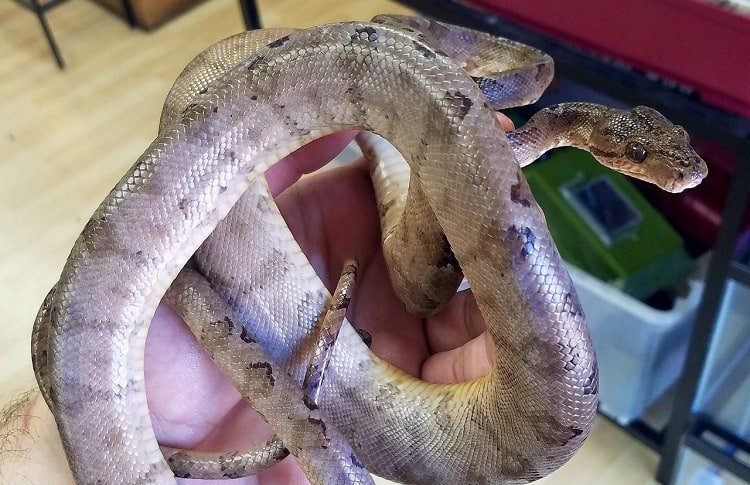
Although many Amazon Tree Boas are wild-caught, some snake breeders use selective breeding to produce unique and creative color morphs of this snake.
Morphs are much more costly to purchase than natural, wild-caught snakes. Here are some popular Amazon Tree Boa morphs.
Halloween Phase Amazon Tree Boa (AKA Garden Phase)
This “morph” is actually just a type of Amazon Tree Boa known as the garden phase! This is a term used for ones that don’t have a variety of colors and patterns on them.
The Halloween Phase Amazon Tree Boa is born with a lot of patterns and bright colors, like red and yellow, but the colors tend to fade as the snake gets older. This snake usually also has a bright red stripe on its body that slowly fades to pink or white as it grows.
Colored Amazon Tree Boa
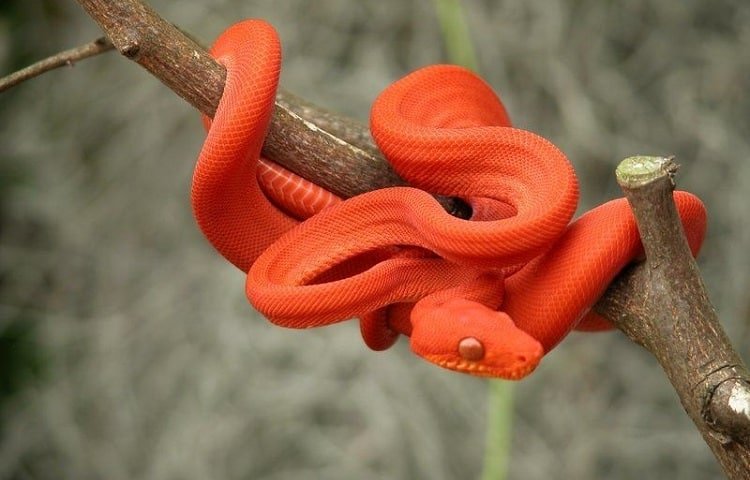
This type of Amazon Tree Boa is a good example of polymorphism. It has a variety of beautiful color combinations, which is the reason for the snake’s name.
You can find Colored Amazon Tree Boas that have a blend of yellow, orange, and red color tones. Some have bold, bright colors on them, while others will have pastel tones.
Interestingly, neonates are usually born with a solid color and without any patterns on their skins. The patterns and colors start to show as they grow.
Paradox Amazon Tree Boa
This morph is one of the most striking and unique. It’s a blend of garden-phase and colored traits. The result is a patchy color scheme that looks like someone threw a lot of paint on the snake.
Some of these snakes have skins that display soft blue, grey, red, and orange colors. Others have yellow and black splotches, along with touches of orange.
Tiger Amazon Tree Boa
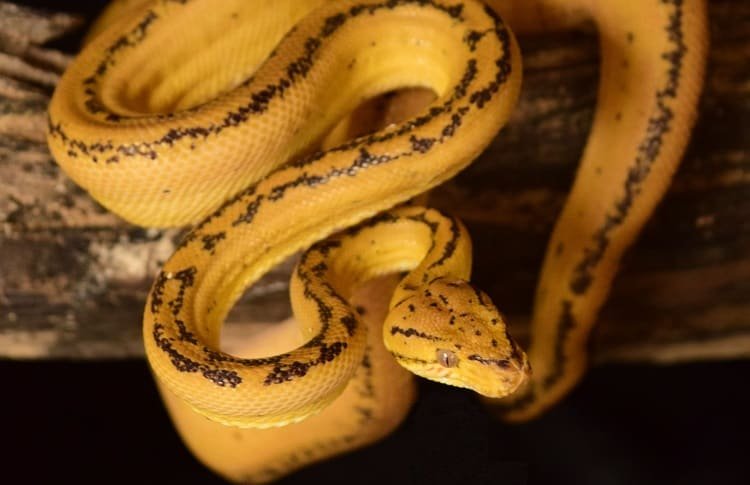
This snake has stripes that are either dark or colored and that run all the way along the top of its body. It also has stripes along the sides of its body, but these tend to be less distinct.
The pattern on the snake is like little dots and triangles, giving it an interesting appearance. As the snakes get older, their patterns become bolder. Some of the most striking Tiger Amazon Tree Boas are those with red or orange bodies and jet-black patterns.
Leopard Amazon Tree Boa
This morph is similar to the tiger morph when it comes to its pattern, but it has more distinct blobs and shapes on it that resemble leopard spots. While that’s beautiful, what’s really amazing about this type of boa is that it has metallic eyes that can be gold or silver!
Related Questions
Are Amazon tree boas ovoviviparous?
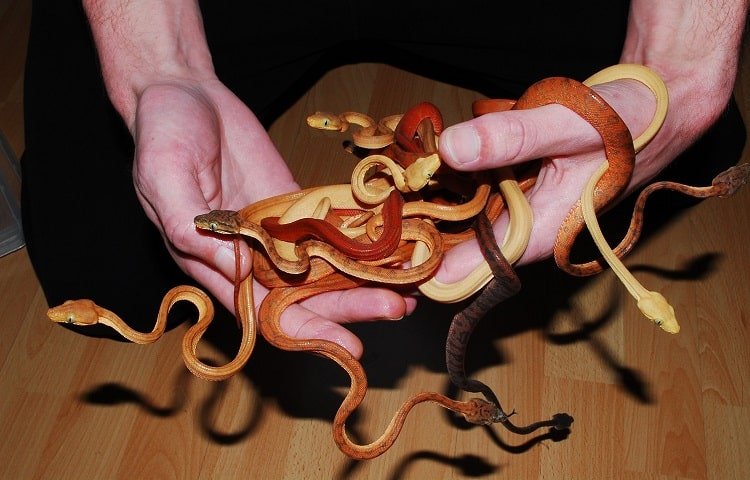
Yes, this means that they give birth to live young instead of laying eggs. Generally, female Amazon Tree Boas will give birth to around eight to 14 young in every litter.
What should you do if an Amazon Tree Boa bites you?
Make sure you wash and clean the wound with soap and warm water. If the wound is bleeding a lot, if you’ve been bitten near your eyes, or if the wound looks like it could be infected, you should seek medical attention.
Amazon Tree Boas: Conclusion
If you’re interested in having an Amazon Tree Boa as a pet, the first thing you need to know is that it’s not an easy snake to own. It has a number of specific needs and it can be quite aggressive.
That doesn’t mean it’s impossible to care for one, though! As we’ve seen in this article, if you give the snake what it needs, it will live a long, happy and healthy life.
We’ve covered all the important things you need to know to properly care for your Amazon Tree Boa, like properly setting up the enclosure and providing the correct temperature and humidity. Hopefully you now have a good idea whether this is the right snake for you, and you feel prepared to properly care for it!
Leave a Reply